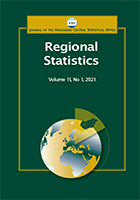Categorisation of regions in the European Union based on smart and inclusive growth indicators for the Europe 2020 strategy
Categorisation of regions in the European Union based on smart and inclusive growth indicators for the Europe 2020 strategy
Author(s): Tímea GyőriSubject(s): Social Sciences, Economy, Geography, Regional studies
Published by: Központi Statisztikai Hivatal
Keywords: Europe 2020 Strategy; cohesion policy; region categorisation; principal component analysis; cluster analysis; spatial autocorrelation
Summary/Abstract: Interpreting regional differences is crucial in promoting regional and cohesion policies. The different levels of development of the regions, their various historical and geographical factors, as well as diverse political attitudes, institutional conditions, and their interactions fundamentally determine the economic convergence processes in the regions. Recent research has emphasised a pluralistic approach in which composite measures of progress and well-being are prioritised. The primary goal of the research was to create a more complex region categorisation model than the traditional gross domestic product (GDP-) based categorisation. This study analyses the changes and correlations of the Europe 2020 Strategy's smart and inclusive growth indicators at the regional level between 2009 and 2019. To create the region categorisation model, the indicators of the strategy were concentrated and then expanded with other background variables into composite indicators, thus creating the main components: ‘Relative deprivation’ and ‘Innovation environment’. The regions were categorised along the dimensions of the new latent variables to form the outstanding, catching-up, and lagging groups, which can be generally characterised by development, catching-up, and lagging, respectively. The outstanding group typically includes the capital of the member states and the regions of their agglomeration. The catching-up and lagging groups in chiefly consist of member states that joined after 2004. The lagging group are mostly external border regions and can be considered underdeveloped along both dimensions; in addition to their below-average innovation environment, their labour market position also lags behind. The model developed in this research provides a more nuanced picture of regional development differences than the traditional GDP-based categorisation.
Journal: Regional Statistics
- Issue Year: 13/2023
- Issue No: 02
- Page Range: 299-323
- Page Count: 25
- Language: English

